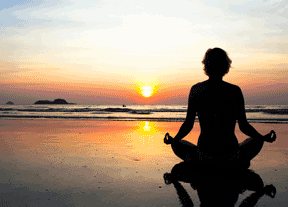In today’s busy world of information, texts, emails and busy lives, meditation has never been so important. In this article, Ricky Parcell breaks down exactly what you need to know.
 MEDITATION – THE BENEFITS
MEDITATION – THE BENEFITS
The ancient practice of meditation has become more relevant than ever in today’s hectic world. It’s a simple and easy way to reduce stress levels, decrease your resting heart rate and achieve a clearer mind. By increasing awareness of breath, and creating space in the mind to use and find creativity and it helps encourage the mind to become quiet and settled.
HOW TO MEDITATE
The most important element of any meditation style is breathing. Breathe in slowly and deeply through your nose, hold it for just an instant at the pinnacle, then as slowly as possible release the breath out your mouth, compressing your stomach down to push the air out of your chest cavity.
You can also feel for your heartbeat and count the beats.
Another popular way to meditate is to repeat a simple mantra in your own mind over and over again.
FOCUS
Another key element is focus. Our minds only hold thoughts for a second or two and then move on, which means we can be easily distracted. Meditation is only effective when we can provide our own self-help and manage our mental fluttering. This is definitely a skill, and one that gets easier with practice! Don’t get discouraged if it takes a little while to get the hang of it. You can’t force it; learn to let it happen. That said, give these meditation tips a try to see what works best for you:
THE STILLNESS
This popular technique involves focusing your vision on a single point until you get the infamous blank stare (or if your eyes are closed, a sort of internal space out). You might stare at a spot on a wall, a candle flame, or a religious or spiritual object. You can also focus on something auditory like chanting or a bell chime.
THE FLOW
This meditation technique is very much like the one listed above except that you will focus on an object in motion – such as a water fall, your own breathing, or something auditory like drumming.
THE CENTERING
This technique takes many different forms but ultimately aims to heighten your awareness of your place in the world. Centering meditation can be either outer (real) or inner (imagined) but the intent is to anchor your perspective in the center of a vivid image in which even the smallest detail is noted. With this technique, you will get into your meditation space then allow yourself to let in an outside noise or thought. This can be a great technique for beginners because of this (if you find it hard to quiet your mind and concentrate). By responding to “distractions” by absorbing yourself in them and therefore dismantling them, you take their power away.
THE VOID
This technique is sort of the antithesis of the three listed above. Like the name suggests, here you will think about nothing. You will have no focal point. You could think of focusing on “the blankness” or “the stillness,” but nevertheless the void meditation is about the complete absence of any internal or external focus. It can be quite challenging but very rewarding and relaxing.
Lastly, for even greater benefits, follow these general guidelines:
Make it a routine. Set aside a certain time each day to meditate, (20 mins is good) like before or after reviewing your vision boards. Put it on your schedule if you have to.
Have a quiet, comfortable place to sit. Remove any distractions from the area (such as silencing your cell phone and putting your dog in the backyard).
Sometimes it’s nice to have a CD playing with relaxing music or nature sounds. This can also trigger to your brain that it’s time to get in meditation mode.
Most people who begin a 30 day period never stop. So if you find it hard to relax, then why not give mediation a go…?
Ricky Parcell, Master coach
[adrotate banner=”48″]
